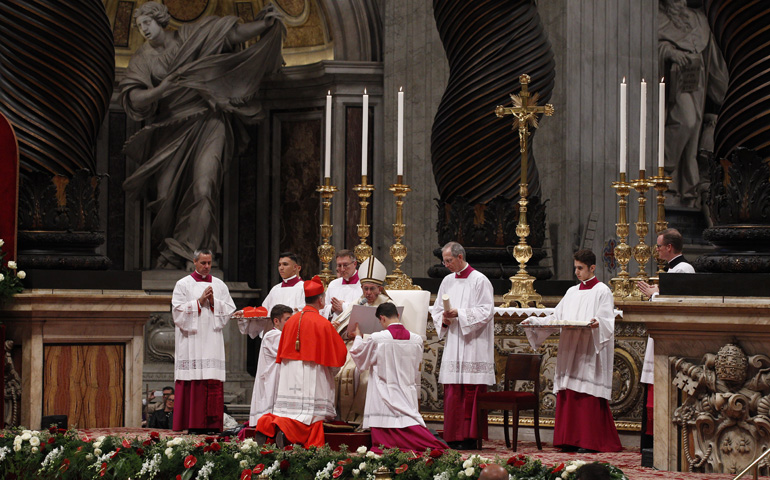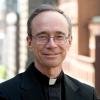
Pope Francis installs new Cardinal Blase Cupich of Chicago into the College of Cardinals during a consistory in St. Peter's Basilica at the Vatican Nov. 19, 2016. (CNS /Paul Haring)
Pope Francis has done numerous revolutionary things during his first four years as pope, but it is hard to top the change he has made to the College of Cardinals. He has changed the system so that an incumbent pope can stack the college with bishops who support his views. This change will have an impact on the church for centuries to come.
This is not the first time the College of Cardinals has been significantly changed by a pope, and it will probably not be the last. One of the most common changes made by popes has been increasing the number of cardinals.
The role of the College of Cardinals in the election of popes goes back to 1059 when the college was made up of senior deacons and priests in Rome plus the bishops of dioceses surrounding Rome.
In the twelfth century, there were positions for about 28 cardinal priests and 18 cardinal deacons in Rome, plus the 7 cardinal bishops for a total of 53. In 1586, Sixtus V set the maximum number of cardinals at 70 in imitation of the 70 chosen by Moses (Exodus 24:1) and by Jesus (Luke 10:1).
John XXIII ignored the 70-member limit, and the college grew to more than 80 cardinals.
In the early 1970s, Paul VI reformed the College of Cardinals by increasing the number of electors to 120, not counting those over 80 years of age who are excluded as electors.
Excluding those over 80 years of age was considered so revolutionary at the time, that the conclave that elected John Paul I held a "confirmation" vote after he had received a two-thirds vote of those present in order to make sure that over two-thirds of all the cardinals voted for him, even counting those not present. They did not want anyone challenging the election.
John Paul II ignored the 120 limit and the number of cardinals reached 135 in 2001, although it was down to 115 by the time he died in 2005.
Besides increasing the number of cardinals and limiting the electors to those under 80, popes have also changed the population from which the cardinals are chosen.
At the beginning, the cardinal bishops were the bishops of the seven dioceses surrounding Rome. The cardinal priests and deacons were the most important priests and deacons in Rome, pastors of significant churches or directors of the church’s charities. As their curial work grew, their pastoral and social work was taken over by others.
Eventually the distinction among the three types of cardinals became more honorific than real, and Pope John XXIII made all the cardinals bishops.
In the eleventh century, Leo IX (1049-1054) began appointing prelates in distant lands as cardinals. Such cardinals were usually required to resign their sees and take up residence with the pope. During the Western Schism, it became common for these cardinals to reside with the pope without resigning their sees. Someone else would administer their diocese while the cardinal collected the revenue. The Council of Trent outlawed this abuse.
Beginning in the sixteenth century, as the College of Cardinals became larger, it became more common for cardinals to remain in residence in their dioceses.
Although cardinals were chosen from elsewhere in Europe, most cardinals were from Italy.
In the seventeenth and eighteenth centuries, approximately 80 percent of the cardinals named were Italian. Pius IX (1846-1878) and Leo XIII (1878-1903) began to broaden the makeup of the college by having only 58 percent of their appointees Italian. The next largest contingents were French (13 percent) and Spanish (8 percent). In 1875, Pius IX appointed the first cardinal in the Western Hemisphere, John McCloskey of New York. From 1903 to 1939, 53 percent of the cardinals appointed continued to be Italian.
True internationalization of the College of Cardinals began under Pius XII, who was elected in 1939 by a college with 57 percent from Italy and 32 percent from the rest of Europe. The percentage of Italians appointed by Pius XII dropped to only 25 percent, with a third of his appointees from outside Europe. He appointed the first cardinals with sees in Africa, India, and China, although the African cardinal was Portuguese. When Pius XII died, only a third of the college was from Italy with another 31 percent from the rest of Europe. The major winner under Pius was Latin America, which went from 3 percent of the college to 16 percent.
Paul VI continued the internationalization begun by Pius XII, but it was easier for him to do this since he has raised the number of cardinal electors to 120. At Paul’s death, 50 percent of the college was European, including 24 percent Italian. The European character of the college did not change significantly under John Paul (49%) and Benedict (52%), although the Italian numbers fell to 16.5 percent under John Paul but rose back to 24 percent under Benedict. John Paul cut back on Italian cardinals so that he could create more cardinals in Eastern Europe.
So, what has Francis been up to?
Francis has continued to increase the non-European character of the college of cardinals. In his recent batch of appointments, only two of the five new cardinals are European. Europeans now only hold 44 percent of the seats in the college. This is the lowest percentage for Europeans ever.
The percentage of Italians is now 20 percent, which is still more cardinal electors than they had at the death of St. John Paul II. This could significantly change next year when five of the seven cardinals turning 80 will be Italian. No Italians were appointed this year.
Surprisingly, the Latin American contingent has not increased significantly under Francis. It has increased only to 17.4 percent today from 16.2 percent at the conclave that elected him, but still down from 18 percent at the 2005 conclave. Unlike John Paul’s appointments from Eastern Europe, Francis has not been favoring Latin Americans.
Africa and Asia have been favored by Francis. They now have more cardinal electors than ever before. Their percentage of the college has gone up to 12.4 percent each under Francis, from 9.4 percent each at the conclave that elected him. Asia and Africa combined now for the first time have more cardinals than Italy.
But the real revolution in Pope Francis’ selections has been his bypassing traditional cardinalatial sees and simply picking any bishop he likes, even an auxiliary bishop. In the past, only archbishops of major metropolitan sees were selected as cardinals. Some sees had had cardinals so consistently over time that their archbishops were considered shoo-ins for the cardinalate. Francis has ignored this unwritten rule from his first appointments.
It is hard to exaggerate how revolutionary this is. It is certainly the most radical change in the College of Cardinals since the reforms of Paul VI.
Why does it matter? It matters because it gives the pope total freedom to pick whichever bishop he wants to be a cardinal. If he had followed tradition, many of his appointments would have been archbishops appointed by John Paul or Benedict. Most of these men would outlive him and help choose his successor.
Francis consciously chose to bypass them for other bishops, some from "insignificant" sees. He picks the man rather than the see. He looks for bishops who support his own pastoral style and vision for the church. This ensures that those he appoints will be more likely to support continuity at the next conclave, rather than reject the direction in which he is leading the church. It ensures that the conclave will be filled with shepherds who smell like their sheep.
With his latest appointments, Francis will have appointed 40 percent of the college of cardinals, just a little less than the 44 percent appointed by Benedict. The remaining 16 percent are hangovers from John Paul.
Progressive Catholics are undoubtedly cheering the pope on as he chooses new cardinals, while conservatives are gnashing their teeth. I must remind my progressive friends that every change has unintended consequences. If by chance, a conservative pope regained the papacy, he could do the same things Francis is doing now. Or just imagine if John Paul or Benedict had tried the same thing that Francis is doing now.
All of this reminds us that no electoral system is perfect. Over the centuries, the church has made changes in the process of electing popes, and for the last century it has probably been working better than previously. But there are no guarantees. It makes me long for the Coptic system where a young blindfolded boy picks the name of the pope out of a glass urn containing the three nominees.
[Jesuit Fr. Thomas Reese is a senior analyst for NCR and author of Inside the Vatican: The Politics and Organization of the Catholic Church, from which some of the material in this column is taken. His email address is treesesj@ncronline.org.]
Editor's note: We can send you an email alert every time Thomas Reese's column, Faith and Justice, is posted. Go to this page and follow directions: Email alert sign-up.




